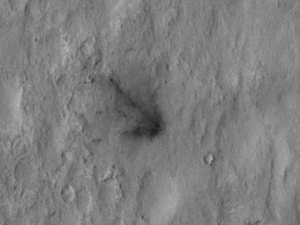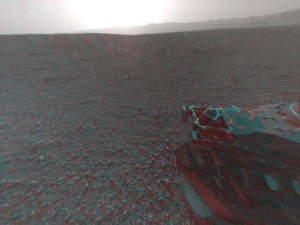Curiosity beams back stunning visuals of Martian landscape
08 Aug 2012
NASA's latest Mars mission has given the world more than just glimpses of a new alien landscape. With video from footage of the landing to a photo of the rover hanging by a parachute to a shot of discarded spacecraft hardware strewn across the surface, the mission opened a window into the trip itself. However, the best views of Mars and the journey have yet to come.
After it parked itself inside an ancient crater on Sunday night, the Curiosity rover has flashed stunning views of its new surroundings, including the 3-mile-high mountain it would drive to. The probe beamed the first colour picture on Tuesday, which revealed a tan-hued, pebbly landscape and the crater rim off in the distance.
Apart from the locale, scientists are getting an unprecedented sense of what it took Curiosity to reach its Martian destination. The roving laboratory beamed home around 300 thumbnails that NASA processed into a low-quality video of the last 2-1/2 minutes of its dive through the thin Martian atmosphere.
The video showed the protective heat shield pop off and tumble away and the footage got jumpy as Curiosity descended in a parachute. The last scene showed dust billowing up just before landing.
The gentle touchdown of the rover on Sunday night marked the end of an odyssey spanning eight months and 352 million miles (566 million kilometers). The touch down came after the rover executed an elaborate and untested landing routine.
 Due to its size, which is about that of a compact car, the rover was too heavy to land using air bags, rather it relied on a heat shield, parachute, rockets and cables to lower itself to the ground.
Due to its size, which is about that of a compact car, the rover was too heavy to land using air bags, rather it relied on a heat shield, parachute, rockets and cables to lower itself to the ground.
Over the next two years, the nuclear-powered, six-wheel Curiosity would chisel into rocks, scooping up soil at Gale Crater to determine whether the environment ever had the right conditions to support microbes. It would spend much of its time driving to Mount Sharp where images from space reveal signs of the presence of water at some time in the past.
It would be several weeks though before the craft takes its first drive and flexes its robotic arm. After it landed, engineers have been busy performing health checkups on its systems and instruments and, over the next several days, it is expected to send back crisper pictures of its surroundings, including a panorama.
According to mission manager Michael Watkins, the rover was "still in great shape."
Meanwhile, 17 miles from downtown Los Angeles, on the campus of NASA's Jet Propulsion Laboratory in Pasadena, a small stretch of earth covered in beach sand, decomposed granite, brick dust, and volcanic cinders called Mars Yard mimics conditions on the red planet. The grainy rock filled layer has a distinctive reddish brown hue.
 The stretch of land off the California coast serves as a scientific sandbox, which researchers at the JPL use to test robotic prototypes of the vehicles they send to the planet. The box, located in the open air, allows simulation of robotic applications in natural light. The colours, sizes and distribution of the rocks are all meant to match the images that have been sent back from NASA's Martian missions.
The stretch of land off the California coast serves as a scientific sandbox, which researchers at the JPL use to test robotic prototypes of the vehicles they send to the planet. The box, located in the open air, allows simulation of robotic applications in natural light. The colours, sizes and distribution of the rocks are all meant to match the images that have been sent back from NASA's Martian missions.
The Mars Yard of today is actually the third version of the rover playground. The first one located where JPL's fire station stands today measured only 80 feet in width and 60 feet in length. The second, which measured 216 feet by 118 feet, was built in 1998, and while that larger space was able to accommodate the Sojourner, the playground proved too cramped for the bigger, more powerful rovers that followed.
In 2006, the JPL started renovating the yard to suit larger rovers it was building, with an expanded Mars Yard opening in 2007, for simulation. The new capacity was demonstrated by a relatively large prototype of a rover that would be named, Curiosity.
The updated version of the yard was not only larger than the earlier versions, it was also hillier. It featured slopes to allow engineers to test how well Curiousity would be able to negotiate Martian mounds. That feature would be put to in situ test soon, after Curiosity landed near the base of Mount Sharp earlier this week.













.jpg)






.jpg)









